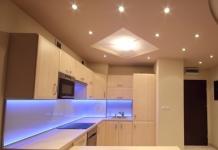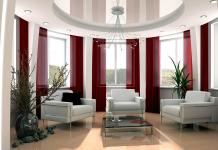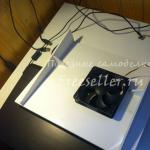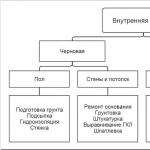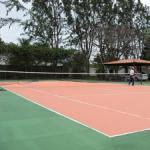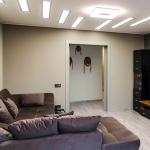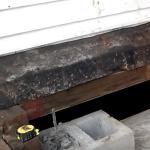Modern design solutions for the design of an apartment or office require the use of the latest technical means. Therefore, having equipped the room with a stretch ceiling, you should take care of the corresponding lamp. How to choose the right lighting fixtures for a stretch ceiling? Let's figure this out.

What fixtures are suitable for stretch ceilings
Stretch ceilings are a panel fixed on a profile (baguette). It can be made of fabric or PVC film. The material has relatively low heat resistance. So, during operation, lamps with powerful lamps (primarily incandescent lamps) strongly heat the surrounding surface. Under the influence of high temperature (over 50 degrees), the canvas may turn yellow, lose elasticity, crack. And this means that its service life will be significantly reduced. To avoid this, you should choose and install the lamp correctly - that's all.
Most often, luminaires with halogen or LED light sources are chosen for stretch ceilings, less often with energy-saving fluorescent ones.
As we have already noted, the material of the tension fabric imposes certain restrictions on the power of light sources. So, the power of halogen lamps should not exceed 35-40 W, fluorescent - 50 W. You should also take into account the design features of lighting fixtures and the shape of the shades. Luminaires should be located at least 15-20 cm from the surface of the canvas.
The installation of "dish" type luminaires in the case of stretch ceilings is strictly prohibited. Due to the tight fit of the light sources to the surface and poor air circulation, the canvas can be damaged by exposure to high temperatures!
If you still decide to opt for lamps with traditional incandescent lamps, then the distance from them to the ceiling surface should be at least 40 cm.
Types of fixtures for stretch ceilings
There are a fairly large number of classifications of lamps: by type of attachment, by design, by design, by light source ... Let's talk about this in more detail.
According to the type of fastening for stretch ceilings, fixtures are most often used:
- Suspended (chandeliers)
These lamps got such a name according to the principle of installation - they are hung on a hook mounted in the base ceiling. In this case, the lamp itself has a special fixture, usually in the form of a triangle. This is one of the simplest mounting options. At the same time, it is important that the master, before stretching the canvas, makes a hole in it in the right place. Then it remains only to strengthen it with a special ring and stretch the suspension through it.
As for the price category, among the variety of pendant lamps there are both budget and elite models - from thousands to hundreds of thousands of rubles. - Overhead
For the installation of overhead fixtures, you need to prepare a mortgage base with a power supply in advance. After the stretch ceiling is installed, overhead rings are glued and holes are made at the location of the lamps, that is, overhead lamps are installed directly on the canvas, literally superimposed on it. Due to the peculiarities of such structures, the power of the lamps used should be taken into account. An ideal option would be LED lamps - with such lighting, the canvas of the shelf heats up slightly.
Overhead lamps, as a rule, are cheaper than pendant ones. - Embedded
Such lamps are attached according to the same principle as overhead ones. At the same time, they have a spring-type mount, which is inserted into a hole in the false ceiling, where the spring straightens out, which allows you to firmly press the lamp to the ceiling sheathing. From the outside, the canvas is decorated with a decorative overlay. Visually it seems that the lamp merges with the ceiling. Such structures attract less attention, their main goal is to illuminate the room. Therefore, they are often used in offices.
As a rule, these are inexpensive lamps.
According to the number of light sources, lamps are distinguished:
- Point
The peculiarity of spotlights is that they are small in size and are designed for one lamp, so several such lamps are needed for full lighting. They look good in the kitchen, in the bathroom, in the hallway. The illumination zone of such devices is usually not more than 30 degrees, so they should be installed in rows.
Prices for spotlights are quite low, the average cost of one is 500–1500 rubles.
For general lighting fixtures, the radiation angle should be at least 60-90 degrees. For local lighting, lamps with an angle of at least 40 degrees are used.
- Cascading
These are built-in structures, which are a platform on which several lighting elements are fixed - screwed-in ceiling lamps or suspended lamps. Cascading structures create an atmosphere of refined elegance in the room, help to delimit the zones in the room. In recent years, there has been a trend in the design environment to place cascading lights above the dining table.
Designers offer many original models. However, these products are not cheap.
In accordance with the ability to adjust the luminous flux, lamps are distinguished:
- Static and rotary
The former do not have moving elements and provide "stationary" lighting. The latter have a movable outer part. This makes it possible to adjust the direction of the light beam, which would be appropriate, for example, during the reception of guests - to illuminate the faces of those present at a large table.
Depending on the light source used, products can be classified into:
- LED luminaires for stretch ceilings
Such lighting devices work with the help of a semiconductor - an LED. In it, unlike a conventional incandescent or fluorescent lamp, the electric current is transformed directly into light radiation. LED lamps give a warm yellowish or cool white light, almost do not heat up, they are durable, have a long service life, and are also energy-saving. They, perhaps, have only two drawbacks - the high price and the impossibility of replacing the lamps (usually they are built into the lamp): in the event of a burnout, the entire lighting fixture will have to be changed. - Halogen lamps
Lamps with halogen lamps have a very high quality color reproduction, high brightness and a clear direction of radiation. Compared to LED lamps, they do not have high energy saving rates. But if we compare them with incandescent lamps, then halogen lamps have a higher luminous efficiency and last twice as long.
Usually small lamps are inserted into the halogen ceiling lamp, sometimes they are not even visible. - Energy-saving fluorescent lamps
Any lamp, including one located on a stretch ceiling, becomes energy-saving when energy-saving fluorescent lamps are inserted into it. Their peculiarity lies in the fact that they have a very high light output - the ratio between the luminous flux and power consumption. This allows you to save energy. However, such lamps are large in size and they can not be placed in every lamp.
If you do not want your eyes to hurt when you look at the lamp, choose models with a dark light reflector function. The outgoing light beam in them is soft.
Prices for fixtures for stretch ceilings
The price of lighting fixtures for a stretch ceiling consists of many factors. These are: the country of origin, the materials from which the lamp is made, its design.
So, prices for pendant lights for suspended ceilings range from 2,000 to 20,000 rubles on average. For example, the Bokal pendant lamp from the manufacturer Citilux (Denmark) - one glass shade, with a maximum power of 100 W, costs 2290 rubles. The elongated vertical shape allows it not to come into contact with the stretch ceiling. This model is perfect for kitchen lighting.
Overhead lamps cost an average of 800-5000 rubles. Available offer: LED lamp from the manufacturer Horoz (Turkey) "Supplied circle" with an aluminum case and a power of 18 W for 1047 rubles.
Spotlights can be selected in the range of 100-1500 rubles. For example, a Novotech Window 369110 spotlight from Novotech (Hungary) made of aluminum and frosted glass with a power of 50 W costs 350 rubles.
A feature of cascading lamps is the intricacy of design. On average, they cost from 20,000 and above. Thus, the cascading chandelier Cascade T522-PT40x100-G (Maytoni), made in Germany, which is a luxurious inflorescence of crystal beads, costs 62,330 rubles. This lamp is designed for 12 lamps and has a lighting area of 48 square meters. m.
Thus, the prices for ceiling lights for stretch ceilings vary significantly, but the range of these products is very wide, so you can choose a lighting fixture for every taste and budget without any problems.
How to choose luminaires for stretch ceilings
When choosing a lamp, you should first of all consider the interior of the room for which you purchase it. Restrained modern, designer chic or classic luxury - it all depends on how you see your room as a whole.
Do not forget about the maximum power of the lamps, but we talked about this earlier.
For a fabric web, the choice of fixtures is wider, as it tolerates high temperatures well. Suitable for halogen, energy-saving, and LED lighting fixtures. For PVC, LED lights are ideal.
On a stretch ceiling, you can install both one lamp and a number of spotlights, or both types can be used. Note that the modern design of the premises involves several light sources, so the lighting system should be carefully considered. Be sure to take into account the geometry and design of the fixtures: round or square, plain or patterned, etc.
As we have seen, installing the right lighting for you will not be a problem. The main thing is to take into account all the nuances of the room, the technical characteristics of the lamp and the features of the stretch ceiling. If you approach all this thoughtfully, the result will exceed all expectations.
For mounting on a stretch ceiling is not an easy task for someone who encounters this for the first time. In search of the optimal solution, you will inevitably come across a number of questions: how to choose a chandelier for a stretch ceiling in low rooms, which fixture of the chandelier is more suitable, whether the stretch ceiling fabric will not burn out from the lamp, etc. In this article, we will touch on a wide variety of nuances that you should pay attention to when choosing fixtures for a stretch ceiling.

Choosing a chandelier for low ceilings - 2.50-2.6 m
Perhaps the main concern when choosing a chandelier with low ceilings is the following: what if the chandelier burns the ceiling.
Of course, if you thoughtlessly buy the first lamp you like, then you can probably expect such consequences. However, if you are reading this material, it means that you have approached the choice thoroughly.
Do not forget one rule: if you use incandescent lamps, then the minimum distance from them to the ceiling is 30-40 cm (depending on the power of the lamp). This particular space is enough to dissipate the heat of the lamp. Neglect this distance - and the ceiling will overheat, deform, and therefore not avoid replacing it.

There are perhaps two versions of the central lamp suitable for the stretch ceiling in the room: either it is a ceiling lamp in the form of a single glass ceiling-plate above which several lamps are installed, or still a real chandelier on a small leg, consisting of several horns. At the same time, the ceiling lamps of this chandelier, the lamps in them and, accordingly, the light is directed downwards.
This is necessary in order to provide the necessary air gap between the lamp and the ceiling.

The plate luminaire with which we started the discussion must be equipped with LED or energy-saving compact fluorescent lamps, since the base of the luminaire with lamps is located directly on the ceiling canvas. These types of lamps with sufficient brightness are commonly called lamps of "cold" light. Many people think that these lamps do not heat up at all. This is an erroneous opinion, since the perpetual motion machine has not yet been invented, i.e. everything that glows - heats up, although to a lesser extent than incandescent lamps.
If the options for the central lamps described above do not suit you, and you definitely want a luxurious crystal chandelier on a chain, be prepared for fairly large sacrifices, namely, in order not to beat your head against the elements of the chandelier, the chain will have to be shortened to a minimum.
At the same time, the candle lamps of such a chandelier will practically rest against the ceiling canvas, violating the unshakable rule about the permissible distance, which means that it will be necessary to install energy-saving lamps of “cold” light. These candle-shaped lamps are already available in every hardware store, but their design and glow will most likely not suit you. After all, crystal looks truly luxurious only when illuminated by transparent halogen lamps or incandescent lamps.
If the ceiling height is 2.8 m or more...
If you have high ceilings, congratulations. Choose any type of chandelier because you can really afford it! You will not make a mistake with the choice if you prefer a hanging chandelier: it will harmoniously fit into the space and will be as harmless as possible to the ceiling. Although, again, you are free to choose what you like, most importantly, remember our rule: there should be 30-40 cm from the lamps to the canvas.

Spotlights: pros and cons
There is a huge degree of probability that when drawing up a contract for the installation of stretch ceilings, company representatives will offer you to choose recessed fixtures as lighting fixtures. There are a great many of them on the market now: all kinds of cubes, balls, "berries" ... eyes run wide.
The same models, only in a much larger assortment, including new items from expensive Italian factories, can be offered to you by online lighting stores and specialized salons.

The undoubted advantages of spotlights with a protruding light bulb: an attractive price, ease and clarity of installation, spectacular results (especially on a matte ceiling) in the form of highlights and patterns. But the most important thing in our case is that such lamps do not overheat the ceiling. The main and, perhaps, the only negative is the frequent burnout of halogen lamps. Although a similar problem is solved by installing high-quality transformers and lamps for 12 volts, or voltage stabilizers. In the case of stretch ceilings, this will cause some difficulties associated with their installation.
There is another, slightly less popular solution - built-in "rims" for "recessed" reflector lamps (MR16).
These lamps are intended, first of all, as an addition to the main lighting of a chandelier in large rooms or as the main lighting, since although such lamps do not give crazy glare, you see, not everyone may like these glare. Headbands can be made of expensive or unusual materials, with an interesting texture and ornament.

There is one “but” when using “rims” on a stretch ceiling with standard halogen reflector lamps: the effect of the so-called “flare” when you see a halo of light around the fixtures, which is not very good. This light can highlight all the communications that the ceiling has hidden. The solution for today is the use of LED lamps, which do not give light to the space above the ceiling. And no “lights”, only comfort and coziness! But by placing an LED lamp in the aforementioned “berry”, the brightness from it will be relatively small, and there will be much less glare and, therefore, beauty.
The use of LED strip around the perimeter of the room.
A good way to both illuminate the room with soft diffused light, which is especially necessary for watching TV or a leisurely conversation with the family, and in vain to part with money with inept tape editing.

An electrician gluing the tape must necessarily have the sad experience of gluing it under a stretch ceiling. Well, if he does not need such an experience, then it is worth experimenting with a piece of tape in order to avoid misunderstandings later. In fact, the task is one and only - to provide smooth light sliding along the ceiling without the effect of a green-dirty strip at its beginning and points of discrete glow of the LEDs.
On our own behalf, we say that the LED strip most effectively illuminates a matte stretch ceiling at a height of 2.7 meters and above.
We hope that our advice will be useful, and you will avoid possible troubles and disappointments associated with the illiterate choice of a stretch ceiling lamp. But no matter how much we write, and you read, forums and articles in magazines and the Internet (like this one) will not replace 100% live contact with lighting specialists. After all, it is impossible to write about all the subtleties, tricks and solutions.
Good luck with your choice and good repair!
In one work it is almost impossible to consider all the issues of lighting an apartment with stretch ceilings. A series of articles will be devoted to this problem on the site, in which the following will be considered separately:
- types of fixtures;
- location of lighting fixtures on the ceiling (article "");
- technology of installation and replacement of lamps.
In order not to be repeated in each work, this separate material contains general questions, which will be discussed below. This is the selection of lighting fixtures for the general style of the interior, the choice of the color of the luminous flux, the level of illumination of various rooms and the effect of the lamp base on the organization of lighting, as well as the basic concepts of light sources.
Lighting in interiors of various styles
When choosing the type of fixtures, you need to remember that it is not just a source of light, but also an element of interior design. Therefore, it is important to know not only which fixtures are suitable for stretch ceilings, but also how successfully they fit into the chosen interior style.
Classic. Style implies restraint in design - nothing superfluous, going beyond a strictly defined framework. Requires expensive, exquisite pieces of furniture. The same applies to lighting. Only the central one, only an expensive chandelier made of crystal, glass or metal.
No additional spotlights. It is allowed to place sconces made in metal and glass on the wall. Recently, designers are increasingly using LED strips placed on a multi-tiered ceiling around the perimeter of the room. This approach, on the one hand, violates the classical canons, and on the other hand, emphasizes the severity and richness of the decoration of the room.
Modern. The style was formed under the influence of classical interior design techniques. A characteristic feature is the smoothness and naturalness of the lines, giving way to an unexpected asymmetry of forms. The presence of a chandelier made of frosted glass and metal is mandatory, but additional light sources are allowed: overhead (lamps made of glass or crystal) and built-in, as well as LED strips.
Often there are design solutions for the organization of light, when all of the listed types of lighting are applied simultaneously. Art Nouveau style in lighting is well suited for a children's room, bedroom, kitchen.
It is characterized by a rustic (provincial) style of interior design. For him, the central lighting of a multi-track chandelier of airy forms is ideal. Plafonds can be made of textiles with a discreet pattern in pastel shades or natural materials. Well fit into the interior and additional spotlights located along the walls.

High tech. The design in this style should have a clear and simple geometry, no decorative ornaments, a large amount of metal. This is one of the few styles in the interior where the classic lighting, the chandelier, looks pretentious. Overhead fixtures are also not used, although each rule has its own exceptions. Recessed lights go well with LED strip.

The above recommendations are not an axiom. Here, only hints are given in which directions to move, if there is a great desire to adhere to a single style. In practice, fantasy and a subtle sense of beauty mix styles and get an excellent result. Sometimes this is done consciously, in contrast to styles, often spontaneously. Therefore, our advice: do not be afraid and experiment.
The role of the color of the light flux in the design of the apartment
When buying lamps, almost no one thinks about what color the light will emit (many people do not even know that lighting can have different colors), how it affects the psycho-emotional state of a person and how the environment is perceived by the human eye.
To explain the presence of color in light, it is necessary to recall the school physics course, which says that light is electromagnetic radiation emitted by a heated substance. A striking example of the change in color of the emitted light is welding, when the metal begins to cool. At this point, you can see that as the light cools, it goes from blue to white and then to yellow. The same effect for the lamps, only here a slightly different color name:
- warm white;
- neutral or natural white;
- cold white.

Important: this is not about the temperature inside the lamp, which is measured in degrees Celsius and which causes burns on the body, but about the radiation temperature, measured in Kelvin.
The question immediately arises, how to choose a luminaire for a stretch ceiling with a certain color of light? The answer is very simple - light bulb manufacturers write on the package the temperature at which the light flux is emitted (measured in Kelvin, in the SI system it is denoted by the letter K). Using the scale shown in the photo above, you can easily determine the color of the light flux.
The second question involuntarily creeps in: what does this have to do with the owners of the apartment? There are two points here.
- The color of light affects the psychological state of a person.
- In different color flows, the human eye perceives the color design of the apartment differently, which, on the one hand, significantly changes the design of the room, and on the other hand, affects the emotional state in a different way.
Warm (yellow) color. A pleasant glow for the eyes, relieving fatigue after working with a computer or watching TV. It can be obtained from both conventional incandescent bulbs and halogen ones. If desired, with such characteristics, you can find LED and fluorescent light bulbs. Most of all, yellow is needed:
- in the living room (hall) - creates a warm, relaxed, cozy atmosphere;
- bedroom - evokes a sense of calm. In such an environment, the eyes rest from the stress of the day;
- kitchen - dishes look more appetizing in warm light;
- bathroom - soft, warm light flux relaxes, relieves fatigue.
Warm light also has disadvantages. Due to the absence of blue and green light in the spectrum (rays of this length are not emitted), many paints take on a completely different color scheme:
- blue turns to greenish;
- blue fades, turning into dirty blue;
- dark blue becomes black;
- purple glows red.

Neutral white light. Such lighting can be obtained from halogen bulbs and some types of fluorescent. White light practically does not differ from daylight, and therefore, there are no distortions in color perception. It is advisable to install lamps with this color of light:
- in the nursery;
- hallway and corridor;
- above the work table in the kitchen;
- near the mirror - the color of the skin is not distorted when applying makeup;
- over desks where lessons are done or newspapers, magazines, books are read.
Cold (blue) color. Cold (blue) color. Only incandescent lamps are not able to work in the cold spectrum of light emission - all other types of lamps give it out. Cool shades of light flux invigorate and increase concentration. Therefore, the use of cold light:
- in the office above the desktop - increases efficiency;
- in the washing area in the bathroom - it will help to quickly move away from sleep, invigorate;
- in residential areas, the blue spectrum is suitable for modern interior design styles, where there is a lot of space and metal (“hi-tech”).
The perception of some colors by the human eye changes in the same way as in the case of warm light:
- red becomes purple;
- orange is perceived as brown;
- yellow turns to greenish yellow;
- blue and green look bright, saturated.
The level of illumination of residential premises
When organizing lighting in the apartment as a whole and in each room separately, one should not forget about another important feature - the level of lighting. As in the previous case, the owners of residential premises think little about how powerful the lamps should be in each room.
Here, unfortunately, another rule basically works: if there is money, there is more light everywhere; According to sanitary doctors, both approaches are harmful to health - they negatively affect the organs of vision, general condition and concentration, and, consequently, the ability to work.
Many do not associate too bright light in the evening in the apartment with drowsiness and low performance the next day, but, according to doctors, this is the reason. The same thing happens with dim light.
Back in Soviet times, sanitary standards for lighting various rooms in an apartment were developed (located in SanPiN, transferred to SNiP - see table), which builders are guided by.
Standards for illumination of premises in the housing stock.
| Room type | Illumination standard according to SNiP, lx/m2 |
|---|---|
| Bathroom | 50 |
| bathroom | 50 |
| Hallway | 50 |
| Cabinet | 300 |
| Children's | 200 |
| Kitchen | 150 |
| Living room (hall) | 150 |
| Bedroom | 100 |
Based on the above indicators, using special formulas, you can calculate the number of light bulbs and their power for each room. The calculation methodology can be found in one of the works on our website (material "").
At the same time, we note that Western experts have a slightly different approach to illumination standards, as well as other indicators of their measurement (rather demonstrations) - they immediately give the number of W per 1 m 2.
| Room type | Incandescent lamps | Fluorescent | energy saving |
|---|---|---|---|
| W/m2 | W/m2 | W/m2 | |
| Living room (hall) | 20-22 | 13-14 | 5,2-5,4 |
| Bedroom | 12-15 | 8-10 | 2,7-3,4 |
| Kitchen | 26 | 15-16 | 6,8 |
| Children's | 60 | 36 | 15,6 |
| Bathroom | 20-22 | 15-16 | 5,2-5,4 |
| Hallway | 10 | 6 | 2,5 |
Using this table, it is easy to make all calculations for the lighting device in the apartment - the area of \u200b\u200bthe room is multiplied by the illumination indicator in W / m2 and divided by the power of the light bulb, in W.
The above basic principles of organizing lighting in the first case, when it comes to continuing the style of interior design, can be used as recommendations for action, but in the second and third, it must be observed if the health of everyone living in this apartment is expensive.
Modern technologies allow, at a minimum cost, to organize light in accordance with the requirements of sanitary doctors. And the lamps are energy-saving, and the service life of some lamps is several times longer than cheap incandescent lamps - all this ultimately allows you to have bright light at the same cost.
Types of fixtures
The choice of type and type of fixtures also affects the lighting device in an apartment with stretch ceilings. They are attached to the ceiling in different ways, have different shapes, sizes, plinths (for LED lamps, the plinth acts as a ceiling light, which causes light to scatter around the room in different ways), etc. To know exactly which fixtures can be used for stretch ceilings, consider the basic concepts associated with light sources.
By type of attachment
For fastening light sources are used:
- suspension systems;
- embedded;
- overhead.
Suspended. Already from the name itself it is clear that the lamps are attached to the ceiling ceiling using special devices: a hook or a special platform (attached to the ceiling with special suspensions, used only for chandeliers). In the first case, we have a classic suspended mounting option, in the second - its variety, which experts call a ceiling mount (see photo).

This mounting option involves the installation of a reinforcing platform to the ceiling before starting work on the installation of a stretch ceiling. The chandelier is attached to the reinforcing bar with self-tapping screws over the canvas. There are two disadvantages here:
- unpredictable reaction of a stretched ceiling to a breakthrough with hardware;
- the proximity of the light source to the PVC film, which can cause it to overheat.
Therefore, this installation of a chandelier in apartments is not very popular, but in public places (cafe, restaurant, museum, etc.) it allows you to rearrange the chandelier in a place where there is insufficient lighting at the moment (in this case, the platform is of considerable size).
A hook for mounting a chandelier is used much more often. Here, first, a hook is attached with an anchor bolt, then the ceiling is stretched. Under the mount, a hole is cut out in the canvas through which the wires and the suspension (chain, cable) will pass. The edges of the hole are reinforced with special rings that prevent the film or fabric from spreading.

Embedded. A mortgage base with electrical wires is attached to the main ceiling in advance. A hole is made in the stretched canvas. A lamp with special springs is inserted into it, which, straightened, hold it in the platform (see photo). In this case, the light source is almost completely hidden in the space between the stretched canvas and the ceiling.

From the outside, a decorative overlay is attached to the canvas, which at the same time keeps the film from further destruction (instead of a special ring), and serves as a decorative element. Visually, the light source merges with the ceiling, giving the impression of the integrity of the ceiling covering. You can install such lighting devices throughout the apartment, in any room.
Overhead. The principle of fastening is the same as for hidden lamps: a special mortgage base is attached to the ceiling, over which a film or fabric is stretched. A hole is made in the ceiling for electrical wiring, which is strengthened with clamping rings. The lamp itself is installed directly on the stretched ceiling - literally superimposed on it. Hence the name.
Overhead lamps are made rotary (the direction of a light stream is regulated) and non-rotary (after installation shine in one place).

The pros and cons of each type of fastening, their features, methods of installation, repair and replacement of lamps can be found in the works on our website.
According to the number of light sources
There is a huge variety of lamps on sale: chandeliers with a large number of light bulbs, single built-in light sources, LED strips, etc. In this variety, it is rather difficult to determine which fixtures are best for a stretch ceiling based on the number of light sources assembled on one platform. To have some idea about lighting systems with different numbers of light bulbs, let's classify them.
According to the number of light sources mounted on one base, the following can be used to illuminate stretch ceilings:
- Spotlights;
- multi-lamp;
- cascading;
- raster;
- LED Strip Light;
- light lines;
- "starry sky".
Point. Spotlights have become an essential attribute of stretch ceilings - indeed, their combination is stylish and beautiful. They are used for the main lighting, but in some interior design options, single light sources are assigned an auxiliary role - to emphasize the elegance of the chandelier or highlight a certain part of the room. The use of only spotlights is mandatory with low ceilings - they will cling to the chandelier with their heads.
In terms of shape, size, power, methods of obtaining a luminous flux and its color, such lamps can be anything - there is a huge selection on sale, numbering more than one thousand options. Here, the main thing is to choose the right lamp for a particular room.

Some experts distinguish spots into a separate group - directional light fixtures - give a narrowly directed light flux, have a rotary device. The allocation of spotlights into an independent classification category is not important - these are still spotlights.
Chandelier. Well known, classic lamp. In many cases, it is an indispensable attribute of the interior (classic, modern, Provence, etc.). Installed in almost any room of the apartment. It can be made from various materials, have a different number of light sources, be decorated in different ways and perform a different function in lighting a room: create comfort or a romantic mood, a zone of increased concentration (performance) or relaxation.
Modern technologies have made their changes in such a conservative light source as a chandelier. LED chandeliers are on sale.

The chandelier can be installed independently. However, it should be remembered that the presence of several light bulbs can lead to overheating of the ceiling sheet - it will begin to turn yellow, followed by sagging. Therefore, this lamp should be hung at a distance of 20-60 cm from the film (fabric) in order to avoid heating the ceiling over 60 degrees Celsius. In addition, you need to get away from the use of incandescent lamps - you need energy-saving or LED bulbs that operate at lower temperature conditions.
Attention should also be paid to the location of the ceiling lamps. If they look up, the chandelier must be additionally lowered to the maximum distance. If the ceiling height does not allow hanging the chandelier at a distance of 60 cm from the stretched canvas, it should be replaced - otherwise the stretch ceiling will have to be changed.
Cascading. The cascade design of the placement of lamps (not to be confused with cascade lamps) for stretch ceilings has a not very long history - 10-20 years (it has been used for a long time for other types of ceiling). It is a platform attached to the ceiling with a hook, which has several overhead lights or single lamps with a lampshade on a pendant. This lighting design sharply delimits the room into zones, creates an atmosphere of sophistication and elegance. It is especially often used when lighting a bar counter and a dining table.

Raster. Lamps in the form of a raster are used mainly in non-residential premises. They can also be found in large living rooms (halls) of cottages. In small rooms, its light is too bright and clean, in which a small room becomes uncomfortable, in addition, excessive lighting disrupts the psycho-emotional state of family members. The disadvantages include the lack of sophistication in such lamps - a metal honeycomb structure, equipped with reflective mirror plates, closed with a grill.

Represents one of the varieties of LED lamps, made in the form of a transparent plastic tape with small spot LEDs on one side and a layer of glue on the other. Sold in coils of 5 m. Small thickness (only 3 mm) and small width (10 mm) allow it to be mounted in multi-tiered ceilings for decorative purposes (although there are exceptions and such a tape serves as the main element of the lighting system) along the contour of one of the tiers directly behind the plinth. Among the advantages:
- low power consumption;
- long, up to 50.0 thousand hours, service life;
- a wide range of colors (sold, including multi-color, changing color in accordance with the program laid down);
- compactness - they take up little space in the package and do not require special technological solutions during installation.

light lines. More recently, the Russian consumer only got acquainted with built-in lamps, and they are being replaced by light lines. Lighting is provided by LED strip 10 mm wide. Depending on the number of built-in LEDs in 1 linear meter, the power of the tape can vary from 14.4 W (60 crystals) to 24 W (240 LEDs). In the first case, such lighting performs auxiliary functions, in the second it is the main one. The LED strip is mounted on a special profile (see photo). Diffusion of light is achieved by a decorative insert.

This type of lamp has many advantages:
- the original design of the ceiling, which radically changes the interior of the room;
- a clearer division of the room into zones, emphasizing, if necessary, individual pieces of furniture;
- reduced electricity consumption;
- the need to replace lamps disappears for a long time (manufacturers guarantee 50.0 thousand hours of continuous operation);
- can be installed along the seam, which turns the ceiling into a single whole;
- quick installation.
Light lines can be of various shapes, shapes and sizes, which gives free rein to the imagination of their installation.
1 of 5





"Starry sky". Lighting in the "starry sky" version is the most expensive and spectacular design of a stretch ceiling. Here, innovative ideas of using fiberglass as a conductor of light from LED sources are successfully combined with the ability to embed LEDs in PVC film without damaging it.
There is also a technology when the fibers of the LEDs are not brought out, but are hidden behind the web film. During the day, such a ceiling is sterile clean; in the evening and at night, a surprisingly fantastic atmosphere sets in: the stars not only glow, but also twinkle, thanks to the light generator. The most expensive, yet fantastically beautiful option is to mount the optical fiber in Swarovski crystals. Refracted in the stones, the light perfectly imitates the twinkling of stars with different colors.

Attention: you can create the “starry sky” effect in various ways: using lighting (which is what we are talking about) and using backlighting - there are more than 5 methods (technological solutions).
It is difficult to independently perform such lighting. There are many nuances there. Therefore, it is better to entrust the work to professionals.
Type of light used
According to the type of origin of the luminous flux, all types of lamps can be divided into 3 large groups:
- incandescent lamps;
- gas-discharge;
- LED.
Incandescent lamps. The whole history of electricity is closely connected with incandescent lamps. In them, a tungsten filament converts thermal energy (formed during the passage of current) into light - visible and infrared rays are emitted. The thread is placed in a flask, from which air is pumped out - we have vacuum light sources or gas is pumped in: krypton and halogen lamps.
In such light bulbs, only 7-12% of thermal energy is converted into light, in which they are significantly inferior to gas-discharge and LED lamps. Their advantage is only in ease of installation and operation in any conditions, including ambient temperature. On sale you can find light bulbs with a power of 15-1,500 watts.
Discharge lamps. Discharge lamps are based on the ability of gases under the action of an electric discharge to emit ultraviolet rays. The phosphor, a special substance, helps to turn this spectrum of light into the visible part. Such a lamp is an ordinary glass tube made of quartz sand filled with vapors of various substances: mercury, argon, xenon, neon with tungsten electrodes on each side. The inner surface is coated with a phosphor that glows in the visible light spectrum under the influence of UV rays (there is a secondary glow effect).
Such lamps are economical (high light output), emit natural white light, close to daylight. However, they have a big minus - flicker (stroboscopic effect). Using alternating current, the discharge lamp 100 times per second, lights up and goes out - at a frequency of 50 Hz per second, the current passes through zero 100 times. Flicker is not visually visible, but it is very harmful to the eyes. You can avoid the flickering effect if you use two lamps with a phase shift - when one turns off, the second starts to shine.
The light source in the LED lamp is Light-Emitting Diode, abbr. LED (light-emitting diode). These are economical light sources with a luminous flux 10 times higher than incandescent lamps, while with a long service life. The pluses include the absence of components harmful to health in the light bulb, for example, mercury vapor.
The design of each type of LED lamp is unique - it consists of a base, a metal case (each type of base has its own type of case, which is not the case for incandescent and discharge lamps), a board with a semiconductor element - an LED, a power converter and a translucent plastic bulb covering the board.
This lamp has many advantages:
- long service life (about 6 years versus 1 year for fluorescent lamps);
- different color of light, which allows you to choose a lamp for any room in the apartment;
- operation at low heating temperatures of the light emitter: the LED chip is heated up to 75 degrees Celsius, the tungsten filament up to several hundred degrees;
- a different type of base, providing for the replacement of all previous fixtures: incandescent and fluorescent lamps.
Three disadvantages:
- overheating by only 2 degrees (over 75) leads to gradual degradation of semiconductor crystals: tarnishing, and then complete destruction, which requires constant heat removal;
- high price;
- the impossibility of replacing lamps with a G5.3 and GX53 base - they are integral with the lamp.

By shapes and sizes
Trading networks today are overflowing with various modifications of fixtures for stretch ceilings - eyes run wide from a rich choice. Under these conditions, it is important to know how to choose a spotlight for stretch ceilings, depending on its size and shape.
Forms of lamps can be very different. It all depends on the design ideas for interior design. You can use classic and asymmetric shapes, while the body of the lamp and the lamp can be modified (several types of light bulbs in one body and vice versa), have a round or oval shape, be made of metal, ceramics, glass or plastic. For admirers of strict geometric lines, square and rectangular lamps are on store shelves. At the same time, a rectangular body can have spherical, candle-like and spiral-shaped light bulbs.
To summarize the above, the conclusion suggests itself: on the lamp market you can find it ready-made or combine a lamp with a light bulb of any shape to suit the taste of homeowners. The main thing is that their installation should be proportionate to the area of \u200b\u200bthe ceiling and look harmonious with the surrounding interior.

All types of lighting fixtures have standard base sizes, and in relation to LED lamps, and housings. This is done to unify the installation nodes and the size of the holes in the ceiling for point recessed light sources. When choosing the size of an overhead lamp, it is necessary to take into account its weight - the larger it is, the lower the ceiling sheet should be lowered in relation to the ceiling (up to 6-7 cm, instead of 5 cm).
For reference: dimensions of LED spotlights: length - 2-3 cm, diameter - 8-10 cm.
By type of plinth
Lamps have a wide variety of bases, however, in order to organize a lighting system thought out from all sides, it is necessary to have an idea of only 3 types of bases:
- G5.3;
- GX53;
plinth G5.3 Available for halogen and LED lamps. Its peculiarity is that the bulb is inside the case. Several disadvantages follow from this:
- the light is not scattered around the room, but is emitted in the form of an expanding beam (according to the principle of a spotlight), as a result of which the illumination is produced in spots, one from each light bulb;
- placing the lamp completely in the luminaire body leads to its overheating, which requires intensive heat removal. Lack of ventilation complicates the process of cooling the light source. Help aluminum radiators. Replacing metal with composite materials leads to a quick failure of LED lamps and to the destruction of the ceiling canvas;
- such lamps cannot be more powerful than 7 W - they simply do not fit additional semiconductor crystals.

In the modification of the plinth GX53 the light bulb protrudes from the housing by 4-5 mm. This arrangement of the lamp allowed:
- increase the angle of light scattering up to 180 degrees;
- achieve heat removal directly from the surface of the ceiling, which reduced the load on heat removal from the luminaire body;
- to produce, along with static light sources, also rotary ones, which greatly diversifies the design possibilities for lighting an apartment;
- increase lamp power;
- receive all three colors of light (warm, neutral, cold).
The GX53 base is placed in LED and fluorescent energy-saving lamps.

plinth G9 differs from the considered options in that it has a light bulb completely protruding from the lamp body (from the ceiling as well). The luminous flux in such a light source is as diffused as possible, but inferior in terms of lighting efficiency to models with a GX53 base (part of the light is directed upwards and absorbed by the matte ceiling sheet, and the glossy one is secondarily scattered along the walls).
This small disadvantage is offset by significant advantages:
- there is no problem of heat dissipation;
- no power restrictions;
- simple operation - replacing a burned-out lamp is carried out with simple steps: pulling out the old one and installing a new one;
- there are adapters for lamps with a different base;
- a large selection of light bulbs with different types of light;
- affordable price, including for LED lamps.

Which lamps to choose depending on the canvas
The material discussed above does not give an answer, which lamps to choose for stretch ceilings, depending on the stretched canvas. And here there are some nuances:
- PVC film ceiling sheet at temperatures above 60 degrees Celsius begins to turn yellow and then collapse. Polyester (fabric) can withstand temperatures slightly higher, up to 70 degrees, after which it loses elasticity and crumbles (collapses);
- in the film ceiling it is impossible to make holes over 150 mm in diameter, in the fabric ceiling 150-200 mm - the canvas is spreading in all directions. Stabilizing rings do not help either;
- mirror film ceilings ideally show the part of the chandelier hidden from below, which requires a special approach to its choice.
Therefore, when installing lighting, the following rules must be observed.
- It is strictly forbidden to use incandescent lamps in built-in and overhead lamps.
- Incandescent lamps should be on suspensions 30-60 cm long, while their maximum power is allowed for PVC film 40 W, polyester (fabric) - 60 W.
- For halogen lamps, the permitted power is 20 W for film and 35 W for fabric.
- The power of LED lamps is limited to 40 watts.
- The horns of the chandeliers should not look up - even low-power bulbs are capable of overheating the ceiling canvas during prolonged operation.
- Built-in lamps should be compact, no more than 8-10 cm in diameter. If the design solution requires large-diameter fixtures, you need to put an additional platform above the canvas and attach light sources to it.
- When installing chandeliers on a glossy ceiling, their reverse side should look aesthetically pleasing.
Popular manufacturers and prices
The price for any product is formed in the same way: profit is added to its cost (depending on the type of materials from which it is made), and then the markup on the brand (the more promoted, the higher the markup) and on the design solution (author's copies, released in limited quantities, are very expensive). These provisions fully apply to ceiling lights.
Pendant lamps(with one shade) for stretch ceilings you can buy from 2,000 to 20,000 rubles. For example, a Danish Citilux lamp with a power of 100 W costs from 2300 rubles.
Chandeliers are much more expensive due to the larger number of lamps and intricate design - the Cascade T522-PT40x100-G (Maytoni) lamp, made in Germany, costs more than 62,000 rubles. For such a price, it has 12 lamps and a huge number of crystal beads, luxuriously refracting light.
Overhead lamps cost from 800 to 5,000 rubles. There are a lot of affordable and excellently designed light sources out there. For example, the Turkish LED lamp "Supplied circle" with an aluminum case from Horoz can be bought for only 1050-1200 rubles.
Most massively placed on stretch ceilings luminaires with LEDs. They are produced in Russia, and in Europe, and in China. With a huge selection, you need to know which LED lamps for stretch ceilings are better to buy, European expensive ones or Chinese ones with an average price.
Immediately, we note one feature of European manufacturers: they mostly produce lamps with an E26 base, which is not used in Russia (E27 base is used here). Therefore, it is necessary to carefully approach the choice of products from European manufacturers.
Among Russian manufacturers it should be noted:
- Feron is a long-liver of the electrical goods market. Produces a wide range of LED strips and lamps at affordable prices. For example, a Feron LB-70 3W lamp costs from 110 rubles;
- Camelion is a famous European brand. On the territory of the Russian Federation, according to its technology, lamps are produced by JSC Energy Systems and Technologies (JSC EST). Products are distinguished by an original design, which allows to obtain a larger angle of light scattering;
- "Navigator" - the main production is located in Klin (Russia). The price matches the quality - a 10 W lamp costs from 300 rubles.
Attention: Chinese-made Camelion LED lamps are sold on the Russian market. They have high quality, long service life and a higher price compared to similar Russian-made light bulbs.
Global brands are represented by firms:
- "Philips" is the most recognizable name for an electrical goods manufacturer. Lamps can be bought at any department of electrical goods. Prices correspond to the brand - very high;
- Lightstar is an Italian manufacturer. Rushing to the leaders of this market segment thanks to the original design, quality materials and affordable prices. Having the same technical indicators with Philips lamps, including the service life, it keeps the price much lower;
- Osram (Germany). The German origin of the goods does not require additional comments;
- FKK (Japan), Nichia (Japan) - both Japanese manufacturers have been on the Russian market for a long time. Products for reliability and design are among the top 10 world brands. Prices are in the segment between medium and high.
China is represented in Russia by both unknown manufacturers with low prices and firms with recognizable names:
- "Selecta" - sells good quality products mainly through online trading platforms;
- "Estares" is a trademark of the world famous manufacturer MaySun. Let out fixtures completely correspond to technical regulations (norms and specifications).
The commercially available selection of luminaires can satisfy all requests for design and price.
When installing the canvas, it is very important to choose the right light source. Too powerful fixtures can damage the material of the stretch ceiling. You should be careful. To choose the right lighting for a stretch ceiling, you need to consider the size of the room and some other factors.
Some people think that it is appropriate to install LED spots for stretch ceilings. This is wrong. You can also install large chandeliers. But it is not recommended to choose massive structures, as well as plate-shaped structures. The latter can damage the canvas, as they fit snugly against it. High temperatures and poor air circulation spoil the material.

There are several designs that are suitable for the canvas, depending on the fastening:
- Overhead. The design is installed on overhead rings. They are mounted in the canvas after they have been fed.
- Embedded. They are small in size and merge with the canvas, so they do not attract attention. They are mounted using spring mounts that will allow you to tightly press the lamp to the ceiling.
- Suspension. A hook is installed in the ceiling plate, on which the chandelier is hung. This method is suitable for all chandeliers that are not too heavy. For heavy structures, additional fasteners are installed.
The first and second types are spotlights that are installed inside.
Overhead structures are the easiest to install and quite economical. They need low power lamps. This is due to the fact that the distance between the canvas and the ceiling plate will be small. Therefore, overhead structures are more suitable as an additional light source, because if you mount too bright, there is a risk of damage to the material.

Recessed are suitable for stretch ceilings if the distance between the canvas and the platform is large. Then you can use light sources of any power. They are the main lighting.
If you settled on a suspended structure, the dimensions will depend on the size of the room. If the ceiling surface is matte, a classic light source will do. For glossy surfaces there are large chandeliers. For such lamps, LEDs are well suited. They will not heat the chandelier and harm the material.
But still, for a stretch ceiling, it is better to use built-in ones.
Also, don't forget about sun exposure. If you have large windows, you can install a halogen or LED mounted fixture on the stretch ceiling as an add-on.
Spotlights for stretch ceilings how to choose without error?
Spot luminaire designs are in high demand because they are easy to install and are not expensive. They can be different in shape and color.

When choosing a luminaire for a stretch ceiling, some requirements are set:
- The heating temperature is below 60 degrees (if it is higher, the canvas begins to deteriorate).
- Power not more than 35 watts. This is necessary to avoid voltage drops.
- The room should have a mirror surface that could reflect light.
- There should be no sharp ends that can damage the canvas during installation.
- Most often, designs are sold with an already built-in LED. If it burns out, just replace it with the same one.
All of the above requirements are met by LED lamps for stretch ceilings.
If you need the light in the room to fall evenly, raster fixtures protected by a grill will do.
You can also install movable structures. Thanks to special fixtures, you can direct the light to certain parts of the room.

To choose the right spotlight for the ceiling, you must consider the size and shape of the room.
What light bulbs are best for stretch ceilings?
Simple incandescent lamps are practically not used, because they often burn out from voltage drops and they need to be built in a great depth.
That's why others will. But their power must be limited:
- LED (no more than 40 watts).
- Luminescent (up to 45 watts).
- Halogen (up to 35 watts).
Of all the listed light sources, the LED lamp is considered the best, since it does not heat up and does not spoil the material.

LEDs are more suitable for rooms with a low ceiling, since the distance between the ceiling plate and the canvas will be about 5 centimeters. The light is natural and does not hurt the eyes. Such light sources are more expensive than halogen ones, but they use much less energy and last much longer. In addition, when buying such lamps, you have the opportunity to choose a base. Therefore, you can choose lamps without fear that the lamps will be inappropriate.
LED light sources can be divided into two groups:
- The lamp is inside.
- The lamp is outside the case.
LED lamps on the outside of the case are considered better because they diffuse light well. If it is built inside, the lamp will emit only a directed stream of light. Therefore, this option is appropriate if you need to illuminate a certain place in the room.

LEDs begin to shine at full, immediately after switching on.
Fluorescent lights save a lot of electricity. They are different in shape and size. Inside these lamps is a spiral, which, thanks to ultraviolet radiation, spreads light. In order not to damage the eyes, it is necessary to place them 40 centimeters above the level of the head. Also, be careful when installing such a lamp, because it contains mercury inside. LED lighting for stretch ceilings is used less often because it can burn out from frequent switching on and off. These lamps have the highest service life (up to 5 years). When you turn on the fluorescent lamp, you must wait until it warms up (about a minute).

Halogen lamps are similar to incandescent lamps. They serve as a good source of light, work for a long time, and do not burn out from power surges. But they should not be touched with hands, since the traces left damage the structure of the lamp. When installing such a lamp, it is better to use a clean rag or napkin.

Any of the three listed types of lamps are suitable for a spotlight. But be careful not to exceed the allowable power of the lamps to avoid possible troubles with the stretch ceiling film.
Where are spotlights used?
If we compare the chandelier and spotlights as a source of lighting for stretch ceilings, then their choice depends on the room. For example, a chandelier is suitable for the bedroom and living room, and spotlights for the bathroom and kitchen. The latter are better for small spaces and as an additional source of light.
Point light sources are well suited for the corridor so that the ceiling is not conspicuous.

Also, point structures can be made moisture resistant, depending on the room where they will be installed. For example, in the living room, simple ones are better, and for the bathroom - protected from moisture.

A lot also depends on the choice of lamp. For example, LEDs in stretch ceilings are well suited for the kitchen.

Spotlights can also be installed inside wardrobes.
Spotlights can be installed anywhere. They are suitable as the main source of light for small rooms, or additional for large ones.

Conclusion
The best source of light for the canvas are LED lamps. They do not damage the material, and can be used as the main and additional light sources.
Successes in repair!!!
A very responsible approach should be taken to the issue of choosing lighting for a stretch ceiling. Too powerful lamps can ruin the canvas, which, under the influence of strong heat, will lose its elasticity and appearance. To decide which fixtures are best for a stretch ceiling, you need to note the main features of the room: the dimensions and height from the main plate to the canvas. And also take into account personal preferences and style of the room.
There is an erroneous opinion that a stretch ceiling involves the installation of only small light sources. In fact, the usual volumetric chandeliers can also be used to illuminate the room.
However, you should not choose too large designs, as well as lamps in the form of plates. In the latter case, there is a high risk of damage to the tension surface due to high temperature and low air circulation, which occur due to the tight fit of the body to the web.

Luminaires suitable for stretch ceilings differ in the method of attachment:
- Overhead. This option involves mounting light sources on special overhead rings that are installed on the canvas after the power supply is connected.
- Embedded. Small fixtures that do not attract attention and almost merge with the ceiling. They are installed using a spring mount, which allows you to tightly press the light source to the canvas.
- Suspended. All types of chandeliers, which, using special fasteners, are hung on a hook mounted in the main ceiling slab. This is the easiest way; massive models will require the construction of a more complex structure.
Overhead lights are the cheapest and easiest to install. Light bulbs with low power are used in them, because. due to the design, the distance between the ceiling plate and the canvas is too small. Therefore, overhead lights are installed as additional lighting, because. Mounting a light source that is too bright will damage the material. Recessed luminaires, on the other hand, require a greater distance between the canvas and the ceiling, which means that powerful bulbs can also be used. Therefore, they often act as the main lighting.
Which stretch ceiling lamps are best to use
Traditional incandescent lamps in stretch ceilings are practically not used due to the tendency to overheat and the large depth of embedding.

Most often, the following light sources are used, which have power limitations:
- LED (40 W);
- Energy saving (45 W);
- Halogen (35 W).
The ideal lamp for a stretch ceiling is LED, which practically does not heat up and does not spoil the canvas.
LED bulbs are placed in low rooms, because. the required height between the main and false ceilings is 5 cm. They are distinguished by natural light that is pleasant to the eyes. The cost of this type of light bulbs is somewhat higher, but this is offset by low energy consumption and a long service life. In addition, LEDs have several base options. This allows you to choose a luminaire without fear that the lamp will not be suitable for him.
LED lamps for stretch ceilings: which ones are better to choose
LED lamps are able to give an uninterrupted stream of light of various colors, which does not tire the eyes and does not impair vision. It is worth choosing them based on personal wishes and purposes of use.

All LEDs can be divided into 2 groups:
- With internal arrangement of lamps;
- With light bulbs on the outside of the case.
Luminaires with an external arrangement of lamps are the best main lighting for a stretch ceiling. Economical and safe, they help to obtain a diffused beam of light that is pleasing to the human eye.
Luminaires with built-in bulbs emit a directed stream of light. Therefore, this type of LED is used to illuminate a certain area in the room, as well as for zoning the room.
Luminaires for stretch ceilings: how to choose an LED strip
LED strip is an ergonomic type of lighting, which is a strip with electrical conductors on one side and an adhesive surface on the other. It can be used as a main or additional light source.

The LED strip is ideal for illuminating a room with a high frosted ceiling.
The brightness of the lighting depends on the number and size of the LEDs located on the strip. For the ceiling area, it is better to use 30 - 60 LEDs per meter with a warm white glow. Brighter light will "cut" the eyes. In addition, you will need a high-power power supply, which is not so easy to disguise.
What is better in a stretch ceiling: a chandelier or spotlights
The choice of the type of lamp will depend on personal preferences and the characteristics of the room being designed. Chandeliers are great for the main lighting of a large room, such as a living room or bedroom. Spotlights are needed in small rooms (kitchen or bathroom).

To get sufficient lighting, it is important to correctly calculate the number of fixtures. Using halogen or LED bulbs, it is better to install one for every 1.5 square meters. ceiling meters; energy-saving - one for every 2 sq. meters.
Spotlights can be used to illuminate small areas, such as shelves in a dressing room. And also to install together with a chandelier as additional lighting.
Spotlights for stretch ceilings: how to choose the right light source
Spotlights are very popular due to their low cost and ease of installation. A huge variety of shapes, colors and sizes allows you to choose the perfect option for a room of any style and purpose.

In order for the ceilings to last for a long time, the selected spotlight must meet a number of requirements:
- Working temperature, which is not able to spoil the canvas (up to 60 ⁰С);
- The power of the light bulb should not be more than 35 W;
- The presence of a mirror part to reflect light;
- No sharp ends that could damage the ceiling during installation.
An interesting solution would be a design with a movable element, thanks to which you can adjust the direction of the light. Such a lamp will allow you to change the lighting, highlighting the necessary parts of the room.
It is desirable that the point light source also has a wide border that will hide the mounting structure.
Which lamps are suitable for stretch ceilings: choosing the perfect chandelier
When choosing a chandelier for a stretch ceiling, you need to take into account the texture of the canvas, the type of light bulb used and the features of the room. For a matte surface, lamps of a classical shape are ideal, for a glossy surface - unusual and intricate. A lot of bright highlights will be given on the ceiling by chandeliers with open LED bulbs that can be installed directly under the canvas. Such lamps do not heat up and will not cause harm to the coating.

When using halogen lamps, the chandelier must be located at least 30 cm from the ceiling. The choice should be made in favor of the lamp, the shades of which will be directed downwards.
Choosing which fixtures are best for a stretch ceiling (video)
The best lighting option for a tensile structure, suitable for all the features of the room, are LED lamps that do not heat up and do not pose a danger to the ceiling. And also can be used as the main and additional light source, changing depending on the wishes of the owner of the apartment and placing accents in the interior.

